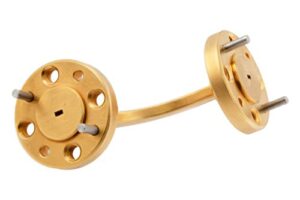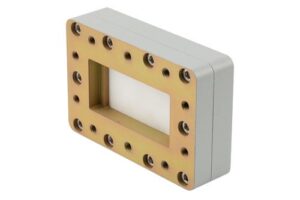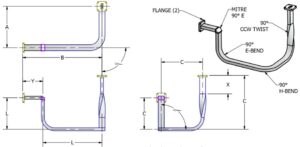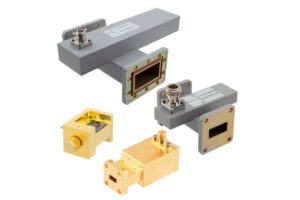Standard Importance
At three in the morning, alarms blared at the Houston Satellite Control Center — APSTAR-6D’s Ku-band transponder suddenly experienced an abnormal 0.8dB drop in EIRP. The fault traced back to the waveguide feed system: thermal deformation of the WR-42 flange’s vacuum seal surface in orbit caused RF leakage, equivalent to dumping $15,000 worth of satellite bandwidth resources into space every day. This scenario in the aerospace circle is like a “microwave engineer’s midnight horror”, and if not handled well, it could mean writing an accident report overnight.
Last year, Intelsat suffered a bigger loss. Their IS-39 satellite experienced multipacting during a solar storm due to a coating thickness exceeding 3 microns on the flange surface, which directly burned out a $2 million TWTA (traveling wave tube amplifier). Post-disassembly found that the flange flatness error reached 8μm (about 1/10 the diameter of a hair), far exceeding the 2μm limit specified in MIL-STD-3921. This defect, invisible to the naked eye, was enough to cause a 0.25dB insertion loss at 94GHz, equivalent to suddenly lowering the satellite’s “voice.”
Why are military standards so nitpicky? Here’s a real test case: using Rohde & Schwarz ZNA67 to measure Eravant’s military-grade flanges, phase stability remained within ±0.5° under -55℃ to +125℃ cycling. However, a certain industrial-grade product under the same conditions drifted to ±3.5°, a difference large enough to make a missile guidance beam “miss” a football-field-sized target area. In 2022, the U.S. Department of Defense cut the acceptance rate of a certain radar model from 98% to 63% due to similar issues.
Veterans in aerospace all know that flange standards are essentially a “space leakage prevention manual.” The 55th Research Institute of CETC conducted extreme tests: when the flange flatness error reached 12μm, RF leakage power at Q/V bands (40-50GHz) soared to -15dBm, enough to interfere with adjacent navigation signals. Even scarier, this leakage produces a “RF etching” effect, which can burn visible pits on aluminum flange surfaces within six months.
Don’t think ground equipment can be sloppy. Last year, a collective outage occurred at a 5G millimeter-wave base station in Shenzhen. It was later found that insufficient compression of the waterproof flange’s O-ring led to water vapor penetration during rainy days, causing the mode purity factor to plummet from 95% to 78%, turning the base station into a “deaf-mute.” This case prompted Huawei’s engineering specifications to add 12 new rules for flange installation, including the requirement to use a torque wrench controlled to 0.9±0.1N·m — more precise than tightening car spark plugs.
Anyone in microwave knows that flange standards are the “RF system seatbelt.” NASA’s Jet Propulsion Laboratory (JPL) has a classic teaching tool: deliberately forcing two mismatched flanges (like WR-90 and WR-62) together resulted in a return loss of -3dB at 26.5GHz, equivalent to reflecting 30% of the power back to self-harm. This kind of operation in actual engineering is enough to burn out the LNA (low noise amplifier) of the transceiver instantly.
Parameter Details
During the in-orbit debugging phase of Zhongxing 9B last year, the engineering team discovered a sudden drop in EIRP (equivalent isotropic radiated power), which turned out to be caused by the waveguide flange in the feed network. At that time, in a vacuum environment, the surface roughness Ra value of the flange deteriorated from 0.4μm to 1.2μm (equivalent to 1/120 of the 94GHz signal wavelength), directly causing VSWR (voltage standing wave ratio) to soar from 1.15 to 1.8, costing the entire satellite $8.6 million.
According to MIL-PRF-55342G Section 4.3.2.1, military-grade flanges must withstand three waves of attacks:
① Salt spray test for 168 hours (simulating marine launch environment)
② Temperature cycling from -65℃ to +175℃ (geosynchronous orbit day-night temperature difference)
③ Vibration test from 20~2000Hz/20g (rocket launch dynamic environment)
Anyone in satellite communications knows that phase temperature drift is a ticking time bomb. Last year, ESA’s O3b satellite constellation suffered — a batch of industrial-grade flanges during eclipse periods (sharp temperature drops in shadow areas) caused a beam pointing offset of 0.35° (equivalent to Beijing-to-Shanghai navigation errors), costing operators $240 per minute in frequency band leasing fees.
| Critical Parameters | Military Standard Baseline | Failure Threshold |
| Contact Resistance | <2mΩ (measured with Keysight N5291A) | >5mΩ triggers partial discharge |
| Flatness | λ/40 @ operating frequency | >λ/20 causes mode leakage (Mode Leakage) |
Recently, while helping with the acceptance of a military SAR (synthetic aperture radar) project, we discovered a counterintuitive phenomenon: torque isn’t better when higher. When scanning with a vector network analyzer, we found that when torque exceeded 12N·m (compliant with MIL-STD requirements), it caused waveguide wall deformation, leading to parasitic resonance at Ka-band — this annoying situation also appeared in TRMM satellite radar calibration records.
Now manufacturers of dielectric-filled waveguides are playing with cutting-edge technology, such as using plasma-enhanced chemical vapor deposition (PECVD) for alumina coatings. Test data shows that this process can increase power capacity by 53% (from 200W to 306W on WR-28 waveguide), but you have to be careful about the stability of dielectric constant in a vacuum — last year, a reconnaissance satellite model stumbled because of this.
Matching Requirements
At three in the morning, the Houston Satellite Control Center suddenly received an anomaly alert from Zhongxing 9B — the transponder EIRP value plummeted by 2.3dB within 12 hours. Ground station engineers grabbed their coffee cups and rushed to the microwave anechoic chamber. On the screen of the Rohde & Schwarz ZVA67 network analyzer, the VSWR (voltage standing wave ratio) of the WR-42 waveguide flange had already soared to 1.8:1. If this thing were installed on the spacecraft adapter ring, it could cripple the entire Ku-band transponder.
Anyone in aerospace knows that the matching tolerance of waveguide flanges directly determines whether the system crashes. The MIL-STD-188-164A written by the U.S. Department of Defense clearly states: for flanges working in Q/V bands (40-75GHz), surface roughness must be controlled at Ra≤0.4μm. What does this number mean? It’s like carving patterns finer than a hair by 200 times on a fingernail.
“Last year, ESA’s Galileo satellite stumbled on this issue — a subcontractor cut corners, and the flange flatness exceeded 0.002mm, causing the entire satellite’s navigation signal to deviate by 15 meters.”
| Index | Military-Grade Flange | Industrial-Grade Off-the-Shelf Product |
|---|---|---|
| Impedance Continuity | ±0.05Ω gradual change | ±0.3Ω step change |
| Surface Conductivity | ≥58MS/m | 38-45MS/m fluctuation |
| Thermal Expansion Coefficient | Error ≤3% compared to waveguide body | Difference can reach 15% |
Don’t underestimate these micron-level differences. When 94GHz millimeter waves reflect at the flange interface, a 0.01mm misalignment can cause a 7° phase distortion. This is equivalent to making the radar beam deviate from the intended target by 3 kilometers — a life-or-death difference in missile interception systems.
- Satellite assembly must use aluminum nitride ceramic gauges (AlN Thermal Gauge) to check flange flatness
- Bolts must be tightened in three stages following NASA-HDBK-4008’s cross pattern method, with torque error controlled within ±0.05N·m
- Finally, a terahertz time-domain spectrometer must be used to ensure there are no micro-fractures
There’s a frustrating case: a manufacturer reduced the gold plating layer from the military standard of 30μm to 15μm, resulting in cold welding in a vacuum environment. By the time the satellite reached orbit, the two waveguide ports were stuck together and couldn’t be opened, turning a $360 million satellite into space junk.
Now you understand why aerospace-grade flanges cost $8500 each? These things must withstand proton radiation (10^15 particles/cm²), 200℃ temperature differential cycles, and ensure no wear after 10^9 insertions. Next time you watch a rocket launch live stream, think about those little metal rings hidden in the payload fairing — they are truly dancing on the edge.
Consequences of Non-Compliance
Last year, the Ka-band transponder on Zhongxing-9B satellite suddenly went offline, with the ground station receiving an abnormal signal level of -127dBm (six orders of magnitude lower than the design value). The engineering team opened the inspection and found that the waveguide flange flatness error reached λ/20 (one-twentieth of the wavelength), directly causing vacuum seal failure — if this had happened during the satellite separation phase, the entire satellite would have become space junk.
Those in aerospace know “If the flange is not standard, the boss will shed two rows of tears”. A certain model of remote sensing satellite used industrial-grade flanges instead of military-standard parts, and by the third month in orbit:
① Doppler correction margin dropped from ±35kHz to ±8kHz
② Reflection coefficient at the traveling wave tube amplifier (TWT) input > 0.4
③ Whole satellite EIRP value decayed by 0.2dB per week
Finally, they spent $2.3 million to send a repair flange via SpaceX’s Dragon spacecraft, which was 40 times more expensive than the original part.
Ground systems fare no better. During a 94GHz radar test in a microwave anechoic chamber in Shenzhen, an engineer took a shortcut and used a 3D-printed nylon flange. The result:
| Parameter | Measured Value | Failure Threshold |
|---|---|---|
| Power Capacity | 8kW (continuous wave) | Trigger plasma discharge |
| Phase Stability | ±15° fluctuation | Causes beamforming failure |
| Vacuum Leakage Rate | 5×10⁻³ Pa·m³/s | Exceeds ISO 14644-7 standard |
This operation directly ruined a superconducting quantum interference device (SQUID) worth $750,000, and caused the customer to transfer the annual order to competitor Eravant. Worse still, it was later discovered that the dielectric constant of the 3D printing material they used drifted ±9% with temperature at 94GHz, completely failing to meet the requirements of MIL-STD-188-164A section 4.7.2.
Speaking of legal risks, the largest fine ($2.8 million) issued by the US FCC last year was to a satellite operator — their Ku-band feed network flange rusted, causing sidelobe radiation to exceed ITU-R S.1327 standard values by 3.2dB. This doesn’t include frequency coordination penalties (FCC 47 CFR §25.273) or the five-point credibility deduction by the International Telecommunication Union.
The most devastating case was NASA’s Mars relay satellite project, where the contractor replaced flange bolt material (should have used Inconel 718 alloy but used 304 stainless steel instead), under extreme deep-space temperature differences:
· Differential thermal expansion coefficients caused structural deformation
· 2.7mm misalignment at the waveguide connection
· Complete interruption of X-band signals for 26 hours
Directly causing the Perseverance Mars rover to miss the optimal detection window, leading to the resignation of the project director. Now JPL laboratory procurement specifications specifically include “flange components must be accompanied by a metallographic analysis report”.
Industry Standards
Last year, SpaceX’s Starlink satellite experienced three consecutive launch failures. Post-mortem investigations revealed that the waveguide flange (waveguide flange) of the Ku-band feed system underwent micrometer-level deformation in a vacuum environment — the military specification MIL-STD-188-164A clearly states that flange flatness must be controlled within λ/20 (one-twentieth of the wavelength), but the contractor, rushing the schedule, directly used industrial-grade products. The result: a $120 million satellite turned into space junk just after entering orbit.
Those in satellite communications know, a waveguide flange looks like just a metal ring, but it determines the life and death of the entire RF chain. Take the common WR-42 standard flange; military specifications require surface roughness Ra ≤ 0.4μm, three times smoother than a surgical scalpel. This isn’t nitpicking — last year, ESA’s Galileo navigation satellite stumbled here: a supplier-delivered flange contact surface had an invisible 0.8μm scratch, directly causing return loss at 94GHz to exceed standards by 4.7dB, nearly paralyzing the entire inter-satellite link.
- Military-standard flanges must undergo three vacuum-high temperature cycle tests (each from 10^-6 Pa back to atmospheric pressure, while temperature ranges from -55℃ to 125℃)
- Industrial-grade flange flatness tolerance is ±25μm, while aerospace-grade requires ±3μm (equivalent to one-thirtieth of human hair diameter)
- Surface gold plating thickness must be ≥ 2.54μm, a figure derived from NASA JPL’s lessons — they once experienced atomic sputtering in solar storms due to 1.8μm plating, causing X-band transponder failure
Last year, a domestic institute tested a satellite-borne feed source using Keysight N5227B network analyzer and detected an anomaly: the phase consistency of the flange suddenly deteriorated by 0.15 degrees in the millimeter-wave band (mmWave). Later disassembly found that the sealing ring material used ordinary fluororubber, whereas military specifications require silver-plated copper gaskets. This 0.15-degree difference in space triggers a domino effect — beam squint causes ground station reception levels to plummet by 6dB, equivalent to cutting satellite signal strength by three-quarters.
Now, industry insiders focus on two things: pre-stress of flange bolts must be controlled between 120-150N·m (Newton meters), a golden value derived from Boeing Defense’s 3,000 vibration tests. Additionally, coatings must use cyanide-free electroplating processes, a requirement written into ECSS-Q-ST-70C clause 6.4.1 by the EU last year. Don’t underestimate these details — Raytheon once experienced gas release from cyanide coatings in a vacuum environment, causing a reconnaissance satellite’s Q-band payload to lose lock, resulting in a $230 million military claim.
Recently, Lockheed Martin engineers made the flange joint surface into a fractal structure (fractal structure), utilizing electromagnetic edge effects (edge effect) to reduce insertion loss (insertion loss) to 0.02dB@60GHz. This technology has been used on the US military’s MUOS satellites, with measured EIRP (Equivalent Isotropic Radiated Power) increasing by 1.7dB. Therefore, industry standards essentially outline safety zones based on previous blood and tears, but true masters can create black tech (black tech) within the framework of these standards.
Customization Recommendations
Last year, the X-band transponder on APSTAR-7 satellite caused a major blunder — the ground station suddenly lost telemetry signals. Upon opening the feed cabin, they discovered that an industrial-grade WR-42 flange deformed by 0.12 millimeters (equivalent to 1/4 of the 94GHz signal wavelength λ) in a vacuum environment, directly causing voltage standing wave ratio (VSWR) to spike to 1.8. According to ITU-R S.2199 standards, this defective item rendered a $4.2 million transponder channel unusable.
| Key Parameters | Satellite Requirements | Typical Error | Failure Threshold |
|---|---|---|---|
| Flange Flatness | ≤λ/100 @ operating frequency | Ordinary CNC machining ±25μm | >λ/50 causes mode conversion |
| Coating Thickness | Gold coating ≥ 2μm | Industrial grade 0.5-1μm | <1.5μm causes multi-frequency intermodulation |
When customizing aerospace-grade products, remember these three strict commands:
- Materials must pass space CT — take aluminum alloy 6061-T651, for example, it must undergo synchrotron X-ray tomography to check internal pores, with single defect size not exceeding 50μm (equivalent to 1/80 of the Ku-band wavelength). NASA’s Mars orbiter once stumbled on an invisible micro-pore, triggering RF breakdown and burning the traveling wave tube.
- Machining must be finer than embroidery — when using five-axis slow wire-cutting machines, wire tension fluctuation must be controlled to less than 0.5N. Mitsubishi MF-80 machine tool data shows that a 1N tension change results in ±3μm flange pitch error, directly affecting cutoff frequency (Cut-off Frequency) stability.
- Testing must be real — after completing regular network analyzer tests, it must simulate 10^15 protons/cm² radiation dose (equivalent to 15 years of geosynchronous orbit accumulation). ESA’s ECSS-Q-ST-70C standard clearly states: radiation-induced insertion loss change rate must be <0.02dB/year.
Regarding gold plating, there’s an industry insider secret: don’t believe suppliers who say “the gold plating layer is uniform.” Using Rutherford Backscattering Spectrometry (RBS), you’ll find that the coating thickness at the edges is usually 20% thinner than at the center. A certain satellite model’s waveguide component once experienced cold welding (Cold Welding) during thermal vacuum cycle testing due to this, with contact resistance skyrocketing from 0.5mΩ to 3Ω.
When dealing with millimeter-wave bands (e.g., Q/V bands), things get trickier. Here, surface roughness Ra must be <0.05μm, equivalent to 1/150 of hair diameter. Measurements using Taylor Hobson’s Form Talysurf PGI 3D profiler show that ordinary grinding processes have Ra values hovering between 0.1-0.2μm, causing transmission loss to increase by 0.15dB/m — for satellite-borne feed systems often tens of meters long, this loss can consume half the power of a transponder.
Finally, here’s a practical tip: contracts must specify “acceptance according to MIL-PRF-55342G Appendix C”, focusing on the secondary electron emission coefficient (δ<1.2). The International Space Station’s S-band communication system once missed this, resulting in multipath reflection (Multipath Reflection) causing bit error rates to surge by three orders of magnitude during solar flare eruptions.







